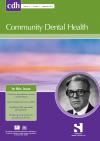Community Dental Health

- Cover Date:
- September 2015
- Print ISSN:
- 0265 539X
- Vol:
- 32
- Issue:
- 3
Clustering of risk indicators for periodontal disease: A population based study
Community Dental Health (2015) 32, 158–162 Received 17 December 2014; Accepted 8 March 2015
doi:10.1922/CDH_3569Bhat05
Clustering of risk indicators for periodontal disease: A population based study
M. Bhat, K. Roberts-Thomson and L.G. Do
Background: To assess the prevalence of clustering of risk indicators for periodontal disease and association of clustering of the risk indicators with sociodemographic factors and the prevalence of moderate/severe periodontal disease in rural Indian 35-54 year-olds. Basic research design: A multi-stage cluster random sampling design was used for this population-based cross-sectional study. Method: Data were collected through in-person interviews relating to sociodemographic factors and habits. Plaque index and periodontal findings were recorded from oral examination. Clustering of risk indicators such as smoking, tobacco chewing, alcohol and plaque were assessed for association with periodontal disease and various other sociodemographic indicators using logistic regression models. Results: Of 1,401 people approached, 873 completed data; a response rate of 62.3%. Clustering of two or more risk indicators was present in 31% of the population. Prevalence of moderate-severe periodontal disease was 46.6%. Simultaneous presence of two/more risk indicators was strongly associated with sociodemographic factors and periodontal disease. Conclusions: Clustering of two or more of the factors plaque, smoking, chewing tobacco and alcohol, was strongly associated with periodontitis.
Key words: periodontal disease, risk indicators, clustering, plaque, smoking, tobacco chewing, alcohol, lifestyle factors, India
- Article Price
- £15.00
- Institution Article Price
- £
- Page Start
- 158
- Page End
- 162
- Authors
- M. Bhat, K. Roberts-Thomson, L.G. Do
Articles from this issue
- Title
- Pg. Start
- Pg. End
- Relationship between family characteristics and children’s regular toothbrushing with fluoride toothpaste
- 132
- 136
- Effect of family caregiver oral care training on stroke survivor oral and respiratory health in Taiwan: a randomised controlled trial
- 137
- 142
- Association of oral health literacy with oral health behaviour and oral health status in Belarus
- 148
- 152
- Comparing UK, USA and Australian values for EQ-5D as a health utility measure of oral health
- 180
- 184
